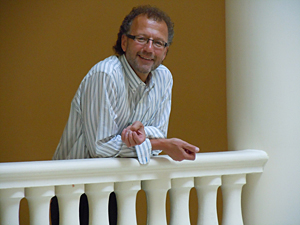ADVERTISEMENT
- Rozovsky wins prestigious NSF Early Career Award
- UD students meet alumni, experience 'closing bell' at NYSE
- Newark Police seek assistance in identifying suspects in robbery
- Rivlin says bipartisan budget action, stronger budget rules key to reversing debt
- Stink bugs shouldn't pose problem until late summer
- Gao to honor Placido Domingo in Washington performance
- Adopt-A-Highway project keeps Lewes road clean
- WVUD's Radiothon fundraiser runs April 1-10
- W.D. Snodgrass Symposium to honor Pulitzer winner
- New guide helps cancer patients manage symptoms
- UD in the News, March 25, 2011
- For the Record, March 25, 2011
- Public opinion expert discusses world views of U.S. in Global Agenda series
- Congressional delegation, dean laud Center for Community Research and Service program
- Center for Political Communication sets symposium on politics, entertainment
- Students work to raise funds, awareness of domestic violence
- Equestrian team wins regional championship in Western riding
- Markell, Harker stress importance of agriculture to Delaware's economy
- Carol A. Ammon MBA Case Competition winners announced
- Prof presents blood-clotting studies at Gordon Research Conference
- Sexual Assault Awareness Month events, programs announced
- Stay connected with Sea Grant, CEOE e-newsletter
- A message to UD regarding the tragedy in Japan
- More News >>
- March 31-May 14: REP stages Neil Simon's 'The Good Doctor'
- April 2: Newark plans annual 'wine and dine'
- April 5: Expert perspective on U.S. health care
- April 5: Comedian Ace Guillen to visit Scrounge
- April 6, May 4: School of Nursing sponsors research lecture series
- April 6-May 4: Confucius Institute presents Chinese Film Series on Wednesdays
- April 6: IPCC's Pachauri to discuss sustainable development in DENIN Dialogue Series
- April 7: 'WVUDstock' radiothon concert announced
- April 8: English Language Institute presents 'Arts in Translation'
- April 9: Green and Healthy Living Expo planned at The Bob
- April 9: Center for Political Communication to host Onion editor
- April 10: Alumni Easter Egg-stravaganza planned
- April 11: CDS session to focus on visual assistive technologies
- April 12: T.J. Stiles to speak at UDLA annual dinner
- April 15, 16: Annual UD push lawnmower tune-up scheduled
- April 15, 16: Master Players series presents iMusic 4, China Magpie
- April 15, 16: Delaware Symphony, UD chorus to perform Mahler work
- April 18: Former NFL Coach Bill Cowher featured in UD Speaks
- April 21-24: Sesame Street Live brings Elmo and friends to The Bob
- April 30: Save the date for Ag Day 2011 at UD
- April 30: Symposium to consider 'Frontiers at the Chemistry-Biology Interface'
- April 30-May 1: Relay for Life set at Delaware Field House
- May 4: Delaware Membrane Protein Symposium announced
- May 5: Northwestern University's Leon Keer to deliver Kerr lecture
- May 7: Women's volleyball team to host second annual Spring Fling
- Through May 3: SPPA announces speakers for 10th annual lecture series
- Through May 4: Global Agenda sees U.S. through others' eyes; World Bank president to speak
- Through May 4: 'Research on Race, Ethnicity, Culture' topic of series
- Through May 9: Black American Studies announces lecture series
- Through May 11: 'Challenges in Jewish Culture' lecture series announced
- Through May 11: Area Studies research featured in speaker series
- Through June 5: 'Andy Warhol: Behind the Camera' on view in Old College Gallery
- Through July 15: 'Bodyscapes' on view at Mechanical Hall Gallery
- More What's Happening >>
- UD calendar >>
- Middle States evaluation team on campus April 5
- Phipps named HR Liaison of the Quarter
- Senior wins iPad for participating in assessment study
- April 19: Procurement Services schedules information sessions
- UD Bookstore announces spring break hours
- HealthyU Wellness Program encourages employees to 'Step into Spring'
- April 8-29: Faculty roundtable series considers student engagement
- GRE is changing; learn more at April 15 info session
- April 30: UD Evening with Blue Rocks set for employees
- Morris Library to be open 24/7 during final exams
- More Campus FYI >>
2:33 p.m., June 9, 2010----Reinhold Steinbeck, learning designer and international educational development specialist from Stanford University, opened this year's Summer Faculty Institute at the University of Delaware on June 1. Steinbeck presented his keynote address, “Design Thinking as a Learning Process: Building Innovation Capacity and Creative Competence within a Global Context,” to an audience of approximately 100.
Before Steinbeck spoke, Paul Hyde, event coordinator, told the audience, “We're trying a number of new things at this year's event. Most importantly, this program is based entirely on UD faculty proposals.”
Hyde and his colleagues in UD's Information Technologies Academic Technology Services (IT-ATS) entered all session titles into an online analysis tool called Wordle. Patterns then emerged based on how often a word occurred.
“When you ask UD faculty to talk about teaching using technology, the Wordle pattern clearly shows that the central element is students. For our faculty, there's a natural focus on students,” Hyde said.
Steinbeck's work with design thinking is also student focused. His presentation illustrated how design thinking enriches students' academic life as well as their life experiences.
What is design thinking?
“Design is really hot. And it's cool,” Steinbeck said. “What's even better is design thinking.”
Steinbeck described design thinking, or DT, as an innovative, human-centered method for instructors to help students learn and solve problems. At its core, design thinking centers on human values -- a person's need to accomplish a task. DT's integration with technology and collaboration is a means for students to develop effective skills to solve complex problems.
“There are two types of design -- big D and little d,” Steinbeck explained. “Big D is what we're all familiar with -- fashion, engineering and architecture. Everything person-made is designed -- we're all designers.
“Little d refers to design thinking,” Steinbeck said. “It's the thinking process behind the design that is important and leads to the learning experience.”
Design thinking encourages students to use visual examples, clearly understand the problem, reflect on the design process, experiment and collaborate. It provides a connection between theory and practice by balancing abstract conceptualization and observation with experience and experimentation.
“To arrive at creative solutions using innovative thinking, you need three key elements: multidisciplinary teams, the DT process and flexible workspace,” Steinbeck said.
It's very important to analyze and answer one of the questions fully -- what the problem is. Understanding the problem brings clarity to the project, the solution and helps identify the type of learning styles that will best work with that problem type. Based on David Kolb's learning model, the different learning style corresponds to the phases of the DT process.
Global projects
Steinbeck has developed and implemented programs in secondary and higher education institutions in Asia, Africa, South America and the U.S. He is principally interested in applying DT and creative problem-solving methodologies to empower communities and improve their socio-economic conditions through education and development.
International programs at Stanford involved partnerships with Chile, South Africa, Tanzania and Uganda. The programs relied on technological means to allow collaboration among program participants. For example, researchers and students in Tanzania collaborated by using smart phones and mobile blogs, also called “moblogs.”
In the education environment, people still rely heavily on the traditional teaching experience in which professors “deliver” content to students. “In a global, design-thinking method, teaching switches from a delivery model to an active construction model,” Steinbeck said.
Stanford University's Design Innovation course (ME310) exemplifies a design-thinking teaching method. It offers students the chance to work with others in universities around the globe. One such example is a collaborative project between Stanford students and those at Pontificia Universidad Javeriana in Columbia.
Students worked in multidisciplinary, global teams to find innovative ways to solve complex problems. “The Columbian university pilot project prepared students to be globally aware, become system thinkers, function across cultures and on multidisciplinary teams and designers of sustainability,” he said.
Steinbeck said that by the end of the course, the ME310 students owned their own learning experience. “They were not doing what someone else told them to do or to learn, but they really engaged in their own learning process,” he said.
Those with interest can view an archived copy of Steinbeck's presentation online through UD's classroom capture system.
Article by Christopher Petrilla




